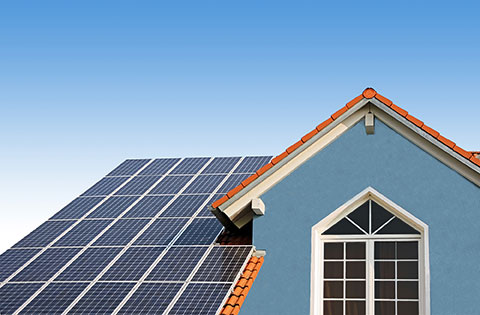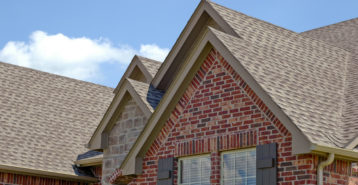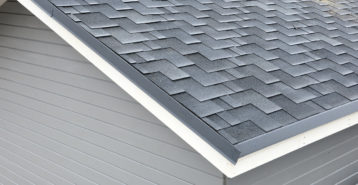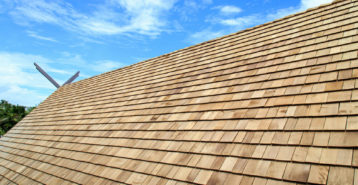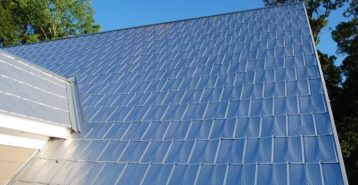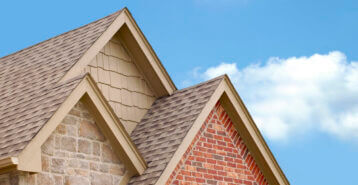What Are Solar Shingles?
Solar panel roof shingles are designed to look like ordinary asphalt shingles while generating energy from the sun. They offer the same durability as traditional shingles and produce between 13 and 63 watts of energy per shingle, depending on the brand. Solar shingles are energy-efficient, lightweight, and easy to install. They’re also built to handle rain, wind, and hail.
While solar shingles cost more than asphalt shingles, they provide added benefits like energy production, electricity savings, and increased home value.
How Much Do Solar Shingles Cost?
As of 2025, the average cost to install solar shingles is $21 to $25 per square foot, or $2,100 to $2,500 per roofing square (100 square feet), including installation and labor. For a standard-size single-family home with a 3,000-square-foot roof, you can expect to pay between $63,000 to $75,000.
Solar Shingles Cost by Area Covered
You aren’t required to replace all your shingles with solar shingles. Some homeowners cover the entire roof while others only do a small section. Here’s what you can expect to pay, based on how much area you want to cover:
| Area Covered (Sq. Feet) | Total Estimated Cost |
|---|---|
| 200 | $4,200 to $5,000 |
| 500 | $10,500 to $12,500 |
| 1,000 | $21,000 to $25,000 |
| 2,000 | $42,000 to $50,000 |
| 3,000 | $63,000 to $75,000 |
Costs vary based on your roof’s slope, pitch, and size, as well as your location and local installation rates. Compare local roofing professionals, including reviews and promotions, to find the best deal.
Solar Shingles Cost per Watt
Installers typically charge by the watt instead of the square foot. This matches how most solar systems are sold, based on energy output rather than size. The cost per watt for solar shingles typically ranges from about $5.50 to $7, higher than traditional solar panel installations, which can cost between $2.50 and $4 per watt.
The higher cost per watt for solar shingles is due to their advanced roof integration, ability to mimic the look of traditional roof shingles, and specialized installation required.
How Many Solar Shingles and Watts Do I Need?
The number of shingles you’ll need depends on your home’s size, energy use, and local sunlight hours. Most solar shingles generate between 13 to 63 watts each, with common models producing 18 to 22 watts each.
To estimate your needs, divide your daily energy use in kilowatt hours (kWh) by your area’s average peak sunlight hours (listed above). Then, divide that number by 18 (the average number of watts produced by a solar shingle). Lastly, multiply this number by 1,000 to account for the difference between watts and kilowatts. For example:
- A New Jersey home using 29 kilowatt hours (kWh) per day and getting 4.5 sunlight hours would need a 6.44 kW system, or about 358 shingles.
- 29 (kWh) / 4.5 (sunlight hours) = 6.44 kW system
- 6.44 (kW system) / 18 (avg. watts produced by a solar shingle) = 0.358
- 0.358 * 1,000 = 358 shingles!
To calculate the cost of this system, take 6.44 kWh and multiply it by 5.50 and 7 (average cost per watt), for a total of 35.42 and 45.08. Then, multiply by 1,000 to account for the difference between watts and kilowatts, for a total of $35,420 to $45,080.
Keeping with the 29 kWh daily energy use estimate, here’s a table to help simplify all of the numbers above:
| Number of Sunlight Hours | System Size Needed | Number of Shingles Needed | Estimated Total Cost |
|---|---|---|---|
| 4.5 | 6.44 kW | 358 | $35,420 to $45,080 |
| 6 | 4.83 kW | 268 | $26,565 to $33,810 |
| 7 | 4.14 kW | 143 | $22,770 to $28,980 |
Always consult a local professional installer for an exact estimate based on your home and energy needs.
Solar Shingles Labor Costs
Labor makes up about 60% of the total solar shingle installation cost. Depending on your roof’s size and steepness, labor costs could reach $40,000.
Some installations also require a licensed electrician to connect the shingles to your home’s electrical system. Be sure to ask your contractor about local permits and requirements.
Other Factors Influencing Solar Shingle Costs
In addition to size, wattage, and labor, several other factors can affect the total cost of solar shingles:
- Roof Complexity: Steep slopes, multiple levels, or unusual shapes increase labor and installation time.
- Roof Condition: If your existing roof needs repairs or reinforcement, those costs will add to the total project.
- Permits and Inspections: Local regulations may require specific permits or electrical inspections, which can vary in cost.
- Product Brand and Type: Higher-end solar shingle brands offer better efficiency and durability, but come at a premium price.
- Warranty and Service Plans: Extended warranties or service packages from manufacturers or installers can increase the upfront cost but offer long-term value.
- Geographic Location: Regional labor rates, energy costs, and incentives all influence your final cost.
What Are the Benefits of Installing Solar Shingles vs. Solar Panels?
Trying to decide between installing solar panels or shingles on your roof? Here are a few advantages and disadvantages to consider beforehand.
Benefits of Solar Shingles
- More aesthetically pleasing than bulky solar panels.
- 10% to 15% more cost-effective than solar panels if you also plan to replace your roof
- Can be removed and reinstalled if you were to move homes
Disadvantages of Solar Shingles
- Sometimes less energy-efficient than traditional solar panels
- You will need a particular roof slope with high sunlight exposure
- Typically have a shorter lifespan than traditional solar panels
- Some solar and roofing installers do not offer solar shingles yet, as they are still growing in popularity
If aesthetics and integration are your top priority, solar shingles are a great option. However, if you want higher efficiency and lower costs, solar panels are the better choice.
What is the ROI of a Solar Shingle Installation?
If your roof needs an overhaul anyway, replacing your roof is a good investment. According to the most recent Cost vs. Value report, a roof replacement has an average return on investment (ROI) of 71.6%.
Additionally, recent Department of Energy-backed studies have demonstrated something else to consider. Home buyers are willing to pay a premium for homes with solar roofing features — up to $15,000 more.
How Long Do Solar Shingles Last?
Most solar shingles last 20 to 30 years, like traditional solar panels. Over time, they continue producing energy, though their efficiency gradually declines — like an aging phone battery.
Manufacturers typically offer warranties for up to 25 years, which helps protect your investment.
When considering solar shingles, it’s important to factor in not only their initial cost and energy output but also their long-term reliability and the specifics of their warranty coverage.
Solar Shingle Repair vs. Replacement
When to Repair
- Ideal for small issues like cracks or connectivity problems.
- Often covered under warranty.
- Can fix underperforming shingles without replacing the entire system.
Note: Finding matching shingles for older systems can be tough, and repairs may not restore full efficiency.
When to Replace
- Best for widespread damage, old systems, or declining efficiency.
- Offers improved performance and may be necessary if you’re replacing your roof.
- Upgrading can increase energy savings and durability.
Use repairs for minor issues. Consider replacement if your system is outdated or inefficient.
How to Save Money on Solar Shingles
Solar shingles can be a significant investment, but there are several ways to reduce costs while maximizing their benefits.
- Take Advantage of Incentives & Tax Credits: The Federal Solar Tax Credit (ITC) allows homeowners to deduct 30% of their solar installation costs through 2032, significantly reducing upfront expenses. Additionally, many state and local programs offer rebates, property tax exemptions, or performance-based incentives that can further lower costs. Utility companies may also provide solar rebates or net metering, enabling homeowners to sell excess energy back to the grid for credits on their electricity bills.
- Install During a Roof Replacement: If you’re already replacing your roof, installing solar shingles at the same time can lower labor and material costs. Insurance coverage may also offset some of the expense.
- Choose the Right Solar Shingle Brand: Brands like Tesla, GAF Energy, and CertainTeed offer different levels of efficiency, durability, and pricing. High-efficiency models may cost more upfront but save more long term.
- Get Multiple Quotes & Negotiate: Compare estimates from several installers. Look for seasonal discounts and consider negotiating — some installers may offer extra perks like extended warranties or free maintenance.
- Consider Financing & Leasing Options: Many companies offer solar loans with low interest rates, allowing homeowners to pay over time rather than making a large upfront investment. Alternatively, Power Purchase Agreements (PPAs) allow homeowners to install solar shingles at little to no upfront cost while paying for the electricity generated at a lower rate than traditional utility prices.
- Maintain Your Solar Shingles for Long-Term Savings: Regular maintenance keeps your shingles working efficiently and prevents costly repairs. Keeping solar shingles clean and free from debris improves their performance, while routine inspections help detect small issues before they lead to expensive replacements.
Finding a Local Solar Shingle Installer
Ready to install solar shingles? Talk to local pros who can explain your options and pricing. They’ll also help you decide if solar shingles are right for your home.
Use Modernize to connect with up to four local professionals and compare quotes.
Compare top-rated roofing pros in your area.
Read real homeowner reviews, explore qualifications, and view promotions. Modernize makes it easy to browse professionals and find one that will be perfect for your project.
